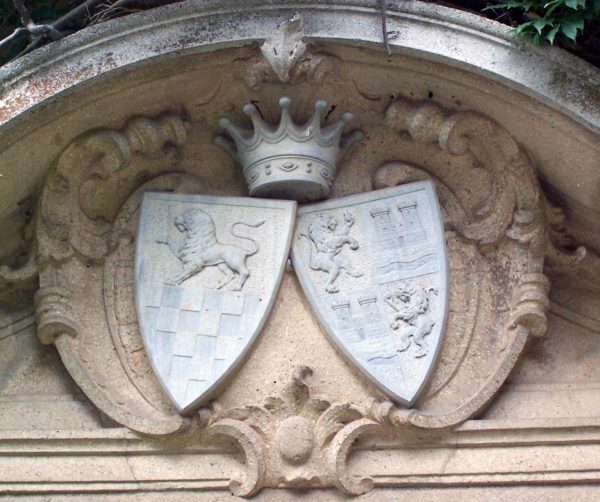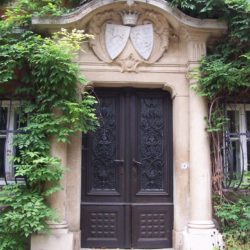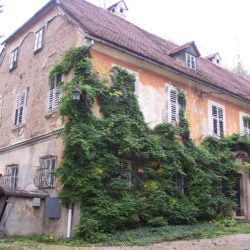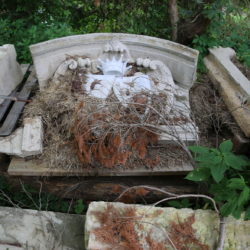
Arms of alliance of the Giesl-Gieslingen and David-Rhonfeld families in Norički Vrh
GORNJA RADGONA, NORIčKI VRH, KUNEJ MANSION
Location of the coat of arms: portal
The beginnings of Norički Vrh Mansion (Narrenbüchel), also known after its prewar and postwar owners as Kunej Mansion, date back to at least the sixteenth century. During the entire eighteenth century, it was also in the possession of the Counts Leslie from Ptuj, who reconstructed it thoroughly and built their coat of arms into the façade above the entrance. The next to introduce changes to the building’s exterior was Paul Ritter von Hempel in the second half of the nineteenth century, who may have also removed the Leslies’ coat of arms and replaced it with his own. Nevertheless, the coat of arms that has until recently graced the entrance was not Hempel’s, but belonged to his successor Wladimir Giesl Baron von Gieslingen, the lord of the mansion between 1914 and 1928. More precisely, it is the arms of alliance displaying the coat of arms of Baron von Gieslingen and that of his wife Julia, née David von Rhonfeld, tucked under a seven-pointed baronial coronet. Although he owned Norički Vrh for less than a decade and a half, Gieslingen left an indelible mark on it. Because coats of arms were customarily carved above the entrance after the completion of restoration, under Baron von Gieslingen the building must have also undergone some masonry work.
Despite his notable trace in world history, the name of Wladimir Giesl Baron von Gieslingen, along with his coat of arms, remains almost completely unknown in Slovenia. According to many, he was one of the figures most responsible for the outbreak of the First World War: in July 1914, his rash actions aggravated the crisis between Serbia and Austria-Hungary to an extent that rendered any peaceful solution impossible.
Wladimir was born in 1860 in the Hungarian city of Pécs. His father, Heinrich Karl, was the inspector general of the gendarmerie responsible for maintaining public order in certain Hungarian counties (comitati). In 1863, Heinrich Karl was raised to the rank of knightood, and in 1883 to the rank of baron, conferred by the second class of the Imperial Order of the Iron Crown. His son Wladimir embarked on a military career and eventually ventured into diplomacy, initially serving as the military attaché to Istanbul and Athens, as an envoy to Montenegro during the Balkan Wars, and as an envoy to Serbia on the eve of the First World War. Although he was hailed as a great connoisseur of the political situation in the Balkans, his warnings were often slighted by the Ministry of Foreign Affairs. Nevertheless, he wrote himself into history as the man that on July 23rd, 1914, delivered an ultimatum to the Serbian government regarding the investigation into the murder of Franz Ferdinand. Heeding the advice of the Austrian foreign ministry, he left Belgrade two days later, and the First World War broke out.
After completing his last assignment, which was to make all necessary preparations for Emperor Karl’s visit to Istanbul in 1917, he retired and moved to his estate of Norički Vrh in southern Styria, which he had purchased in September 1914. There he also awaited the end of the war.
During the battle for Yugoslavia’s northern border, when Rudolf Maister’s combatants seized control of the area between Spielfeld (Sln. Špilje) and Cankova (including Radgona), Baron von Gieslingen expressed his loyalty to them. However, already in 1928 he sold Norički Vrh and moved to Austria. He died in Salzburg in April 1936.
The other coat of arms above the entrance to Norički Vrh Mansion, as already noted, belonged to Gieslingen’s wife Julia, née David von Rhonfeld. Her father Emil (1837–1918), who was elevated to baronial rank in 1902, served as the tutor of the heir to the throne, Rudolf, and the governor (Germ. Statthalter) of Dalmatia. That is where Julia probably learned Croatian, which benefitted her immensely while accompanying her husband on his travels through the Balkans. Their marriage produced their daughter Maria, who died at a young age, and son Hans, whose descendants still live in Salzburg.
Norički Vrh (or Kunej) Mansion was torn down in the recent past, with the heraldic ornaments currently lying in the grass next to the ruins. There are plans to incorporate the disassembled entrance with the coat of arms into a new building, which has been under construction for the current owner since 2021 on the site of its demolished predecessor.
Sources:
Giesl v. Gieslingen, Wladimir: Zwei Jahrzehnte im Nahen Orient. Berlin, 1927.
Gothaisches genealogisches Taschenbuch der freiherrlichen Häuser, 1917, pp. 300–301.
Stopar, Ivan: Grajske stavbe v vzhodni Sloveniji. Med Prekmurjem in porečjem Dravinje (vol. 2). Ljubljana, 1991, p. 93.



